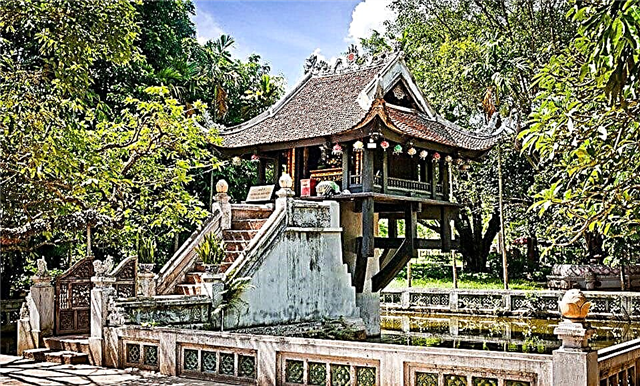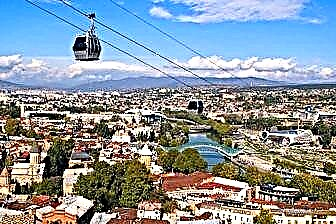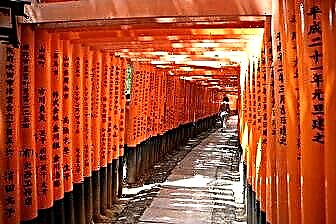The ancient capital of Japan, although it lost this official status, remained one of the main cities in the country. For centuries, imperial families rebuilt Kyoto, giving it its current features. The architectural features of the districts are difficult to convey in a nutshell. The number of buildings in the traditional Japanese style is impressive. These are tea houses, pagodas, and pavilions. There are many wooden structures among them, which is usually not typical for cities with a population of over one million.
The main attractions of Kyoto are temple complexes. Some are converted from shogun palaces and villas, such as the Golden Pavilion. The national characteristics of Japan are not forgotten in our time. A visit to the Gion quarter or Nishiki market allows tourists to plunge into the flavor of the Land of the Rising Sun.

The best hotels and hotels at affordable prices.
from 500 rubles / day
What to see and where to go in Kyoto?
The most interesting and beautiful places for walking. Photos and a short description.
Gion Quarter
The most famous geisha district in the country. It began to form in the Middle Ages. The streets are still lined with old buildings, mainly teahouses, restaurants and machiya - traditional Japanese houses. Tourists have access to geisha lessons: you can learn dancing, playing instruments, ceremonies, or just try on an outfit. The area has been partially declared a National Historic Landmark.

Ponto-cho district
One of the traditional Japanese nightlife areas. The small street is filled with tea houses, restaurants, shops and entertainment venues. In the quarter, you can meet geisha, as well as visit the kabuki theater. Twice a year, an unusual performance is presented in the area - the legacy of the Pontocho Kaburenjo Theater. A colorful show - a symbiosis of dance, playing musical instruments and geisha ceremonies.

Ninen-zaka and Sannen-zaka streets
They are located in the foothills of the Higashiyam Hills. The streets are narrow, they go up steeply, there are steps. There is a superstition: if you fall on Sannen-zak, then death will overtake you within three years. Wooden houses were built on both sides of the streets. There are shops in them. Typical local products are hand-painted pottery. If you wish, you can watch the process of making dishes.

Fushimi Inari shrine
The very first buildings on this site appeared in the 8th century. However, Fushimi Inari began to take shape as a full-fledged Zionist temple only in 1499. Then the main hall was erected. The imperial house actively supported the temple during the Heian period. There are many statues and images of foxes on the territory. These animals are the messengers of Inari, the god of rice. According to legend, the temple is dedicated to his crossing the country.

Golden Pavilion
Part of the Rokuon-ji complex. It was built in 1397 and was the residence of the shogun Ashikaga Yoshimitsu. He finally moved here when he was tired of state affairs. Around there is a vast green area, which includes both man-made parks and "wild" forests. After the shogun's death, the villa was turned into a Buddhist temple. The territory has undergone redevelopment. Religious symbols appeared in the main hall.

Kiyomizu-dera
The temple complex dates back to the XIV-XVI centuries. The translation of the name is “a temple of pure water”. The ensemble includes many buildings and objects. The most notable of these are the main temple, pagoda, prayer hall, bell shed, sutra storage and horse corral. For the most part, the complex is dedicated to the goddess Kannon. Since she is characterized by reincarnation, various images of Kannon can be seen in the temple.

Silver pavilion
Located at the foot of a mountain covered with dense forest. Together with the garden, the pavilion is part of a single complex. The landmark is dated to the end of the 15th century. The palace was built for the shogun Yoshimasa Ashikagi. The two floors are crowned with a traditional-style roof and a Phoenix statue mounted on top of it. A gallery runs along the perimeter of the second floor. A man-made lake was created right in front of the entrance to the pavilion.

Ryoan-ji Temple
Dated to 1450. Included in the UNESCO World Heritage List. He became famous in many respects thanks to his garden of stones. It was created for meditation by Buddhist monks. The site is covered with white sand and gravel and is surrounded by a clay wall. The location of the stones has a certain interpretation. On the territory of the temple is Ryoan-ji Tsukubai - a stone vessel from which the ox is used for rituals.

To-ji Temple
The temple complex was founded in 796. Its main pagoda with a height of 57 meters holds the title of the tallest wooden building in the city. The five-tiered structure is open to tourists only a few days a year. Despite a number of renovations, the complex has remained within the same boundaries and retained its original style. One of the halls of To-ji is the Treasury. Artifacts and values from different periods are kept here.

Sanjusangen-do temple
The construction was completed in 1164. The name can be translated as "Hall thirty-three in length." Do is a measure of length in Japanese architecture. After a great fire in 1249, the temple complex was not completely rebuilt. We confined ourselves to the main hall, which has survived to this day. Sanjusangen-do is famous primarily for the collection of 1001 statues of the goddess of mercy Kannon.

Nanzen-ji Temple
The main Buddhist temple of the city. He has presided over the five Great Temples of Kyoto since 1386. A villa was originally built on this site, and in 1293 it was converted into a religious site. The complex has several temples and two gardens. Two reservoirs have been created in the Southern Garden. Nanzen-ji is famous for holding the longest batch of shogi ever recorded: it lasted a week.

Nijo Castle
Construction started at the very beginning of the 17th century and stretched out over several centuries. The total area of the complex, including the park area and gardens, is 275 thousand square meters. In the past, the castle was the seat of the Tokugawa clan. Here, in 1867, the transfer of power from the last Japanese shogun to Emperor Meiji took place. Since 1940, the territory can be visited by anyone. The castle is included in the UNESCO World Heritage List.

Imperial palace
Construction began in 794. Throughout its history, the palace burned down to the ground several times. During the reconstruction, changes were made to the complex in accordance with the wishes of the emperor who was ruling at that time. The premises were mothballed at the end of the 19th century when the capital was moved to Tokyo. Two more coronations took place in Kyoto. The area around - gardens, otherwise called "imperial park".

Kyoto International Manga Museum
Has been working since 2006. It is also a research center based at Seik University. The exposition includes about 200 thousand copies of the manga. Three floors are occupied by the "Manga Wall": here are the publications of the last five decades. In a manga cafe, you can dine and read, and the visitor pays at the exit for the amount of time spent in the establishment. The museum is open all days except Wednesday.

Kyoto Railway Museum
Covers a vast area and tells about the history of Japanese railways. The heart of the exhibition is 36 trains in perfect condition. Among them are old models - real rarities, as well as modern high-speed trains. A library has been created at the museum, which contains 34 thousand magazines and books about different types of transport, but the railway is in the first place. There are driving simulators on the territory.

Samurai and Ninja Museum
Located closer to the city center. The museum collection covers 5 periods in total from 794 to 1868. Among the items there are especially valuable originals of clothing, armor and weapons. During the tour, the guide talks about the way of life of the samurai and ninja.For a fee, you can take a picture in full attire of Japanese ancient warriors.

Kyoto National Museum
Founded during the reign of Emperor Meiji. The design was carried out by Tokuma Katayama, a follower of Western styles in architecture. Therefore, the building of the museum was erected in the style of the French Renaissance. The exhibitions are divided into three areas: fine arts, crafts and archaeological finds. Permanent exhibitions include not only Japanese values, but also artifacts from other Asian countries.

Nishiki Market
The history of the market goes back several centuries. It is also called "Kyoto cuisine". A narrow street in the central part of the city is surrounded by hundreds of shops and shops. Many of them have been run by families for generations. They sell in Nishiki traditional Japanese pickles, sweets, fruits, fresh seafood and all kinds of dishes prepared right here. Trade goes on until the evening.

Kyoto tower
The tallest building in the city. Height - 131 meters. Construction was timed to coincide with the 1964 Kyoto Olympic Games. The plan caused a lot of controversy. Some believed that the tower would spoil the look of the old capital, while others insisted on the need to modernize the panoramic view. As a result, the tower was erected on a 9-storey building, where shops and a hotel are open. The structure can withstand strong earthquakes and typhoons.

Togetsu-kyo bridge
Thrown across the Oigawa River. Its length is about 150 meters. The name translates as "the bridge that crosses the moon". So Emperor Kameyama began to call him: he noticed that at night it seemed as if the moon was touching the bridge. In December, the area hosts a nighttime lighting festival. Tourists can take a boat ride: the boatmen wait right by the bridge. Locals come here to fish.

Sagano Scenic Railroad
Commissioned in 1990. The length is 7.3 km. Connects Saga and Kameoka stations. Trains use thermal traction, there is no electrification. The trains consist of 5 wagons. Some of them are open. This allows you to take better quality photos. There are several stops along the way. Tourists can go out, buy souvenirs and look around. A huge diorama is of particular interest to travelers.

Maruyama Park
Opened in 1886. More than 800 cherry trees have been planted in the park. The most famous of them is "Gion", the main natural attraction of Maruyama. You can spend time here not only walking or arranging photo shoots. It offers restaurants and tea houses. To the west is the Yasaka Shrine, so many tourists prefer to get there through the park.

Philosophical trail
Also called Tetsugaku-no-michi. Laid at the foot of Mount Higashiyama. The length is about 2 km. There are many temples nearby. The trail runs along a canal lined with stones. The sakura trees planted nearby make the area even more picturesque. During their flowering period, the trail turns into a kind of tunnel of flowers. Tetsugaku no Michi is included in the list of the 100 most popular tourist roads in Japan.

Bamboo forest
Located in the vicinity of the city. For convenience, special paths were laid in the forest and bridges were made: in some places the soil is very loose, and without them it would be problematic to walk. The protected area has been known since the XIV century. Created by monks led by Muso Soseki. Its area currently reaches 15 km². In the evening, lanterns light up along the paths. You can buy bamboo crafts at the entrance.

Iwatayama Monkey Park
Located in the suburbs of Kyoto. The park is inhabited by about 200 individuals - representatives of different species of primates. They feel very at ease here. The area around often acts as a film set, and the park itself is owned by a film company. Monkeys can be hand-fed if you buy special food. The park is located on a hill, so there are wonderful views of the city from here.












